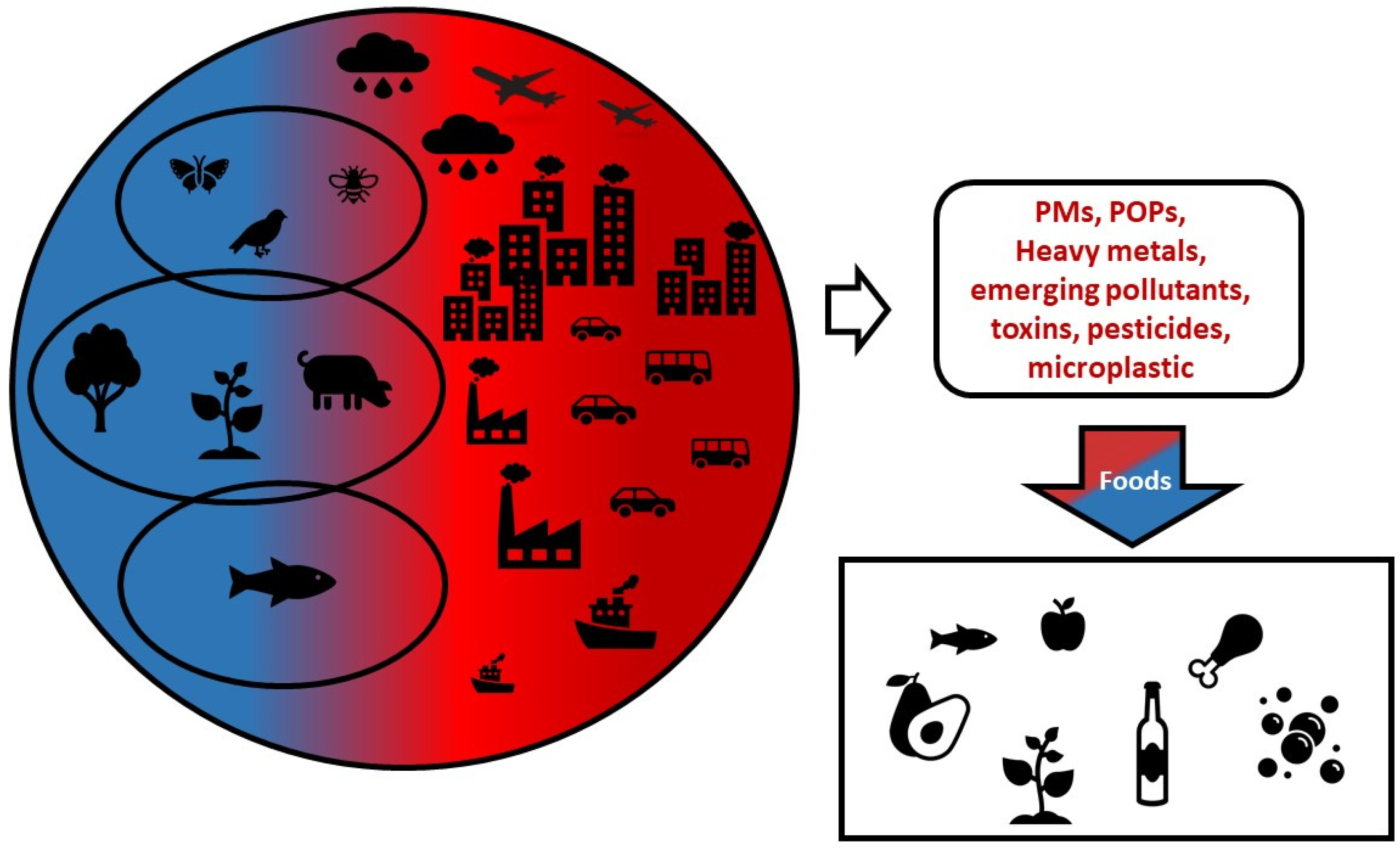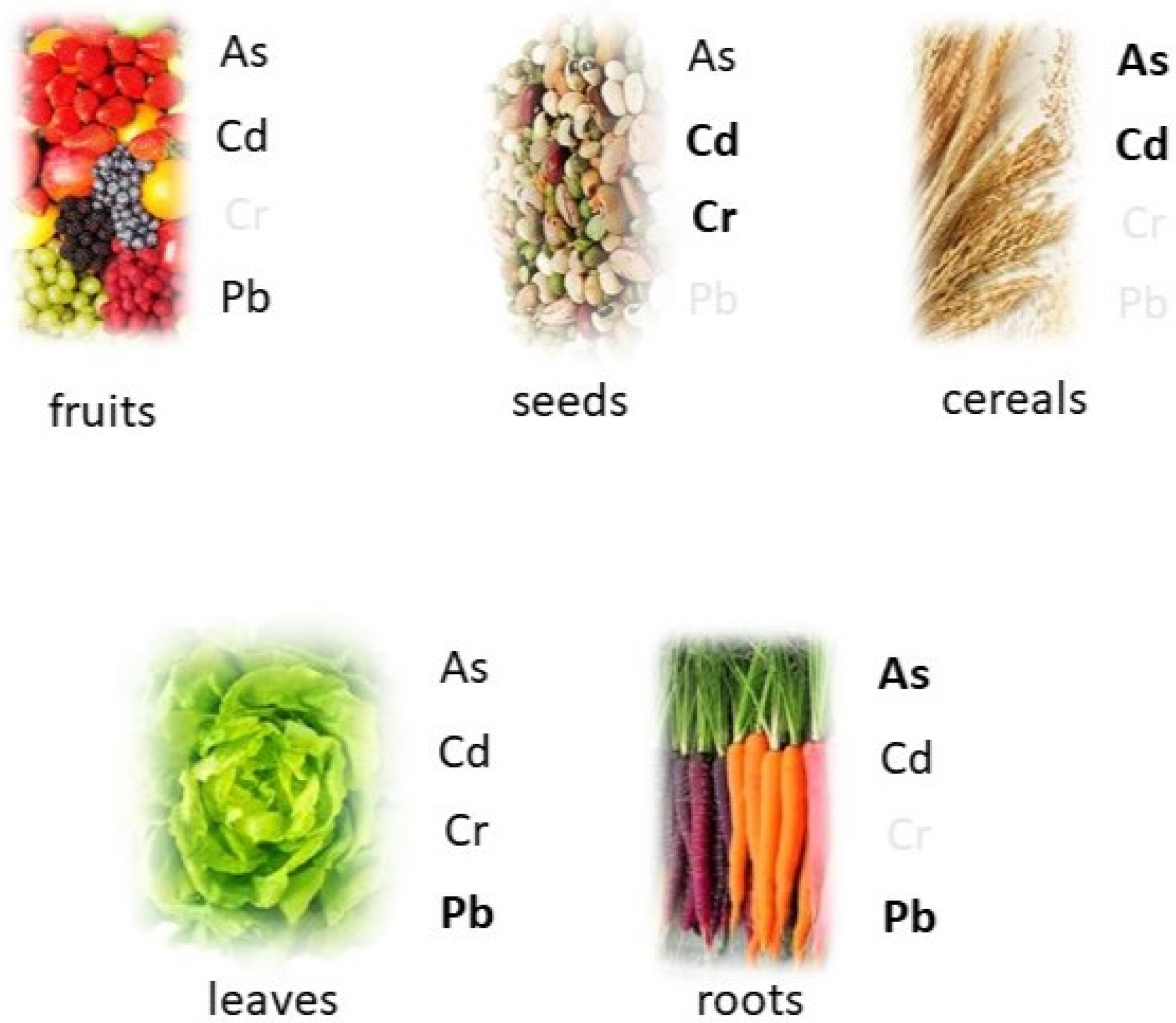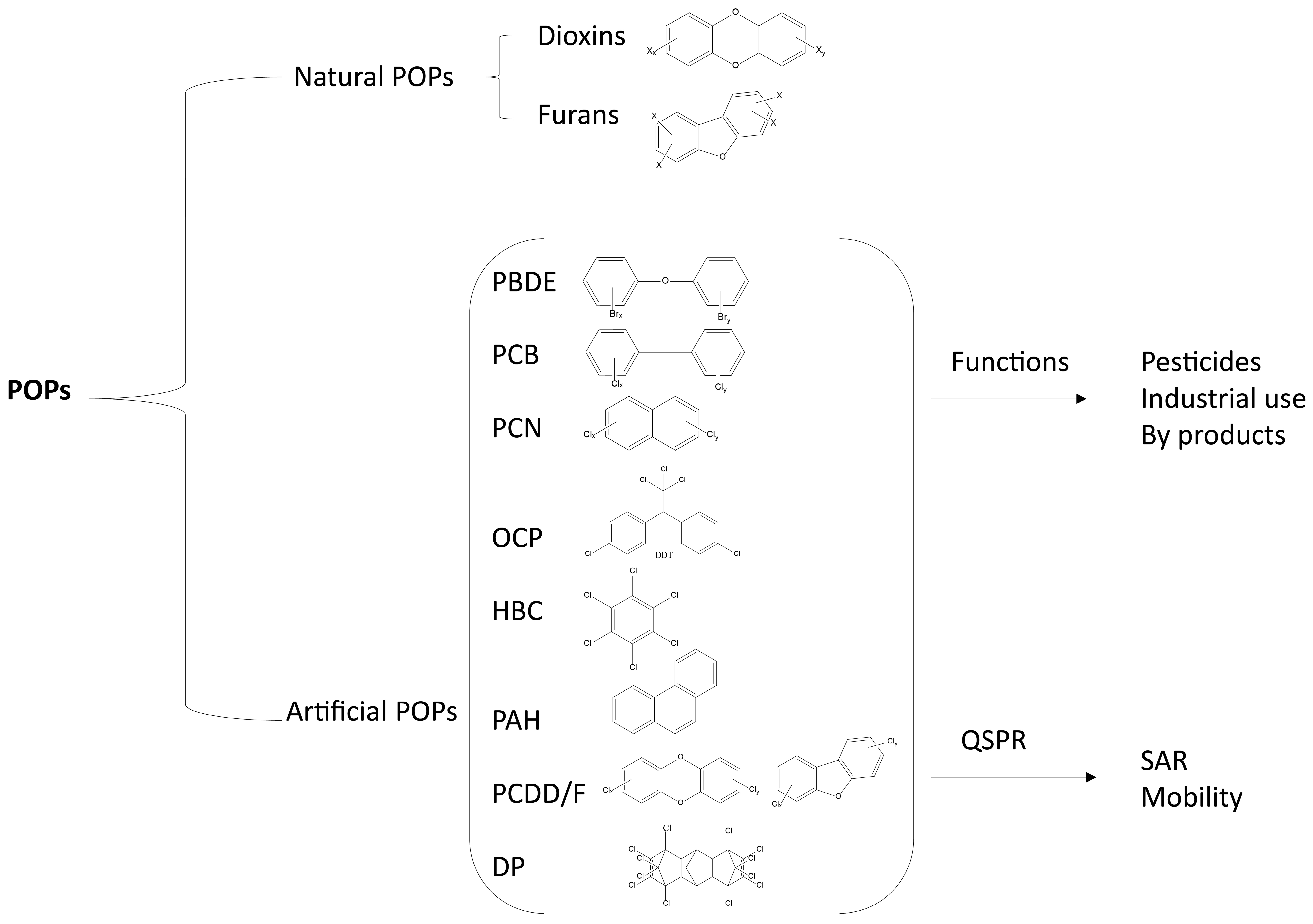Food Plants and Environmental Contamination: An Update
Abstract
:1. Introduction
2. Contamination and Vegetal Crop Systems
2.1. Heavy Metal Contamination
2.2. POPs and Emerging Contaminants
2.3. Other Chemical Hazards
3. Conclusions
Author Contributions
Funding
Institutional Review Board Statement
Informed Consent Statement
Data Availability Statement
Acknowledgments
Conflicts of Interest
References
- FAO; CIHEAM; PRIMA; UfM. Sustainable Agrifood Systems in the Mediterranean—Levers for Transformation; FAO: Rome, Italy, 2023. [Google Scholar] [CrossRef]
- Arora, N.K.; Mishra, I. United Nations Sustainable Development Goals 2030 and environmental sustainability: Race against time. Environ. Sustain. 2019, 2, 339–342. [Google Scholar] [CrossRef]
- FAO; UNEP; WHO; WOAH. A Guide to Implementing the One Health Joint Plan of Action at National Level; FAO: Rome, Italy, 2023; 52p, Available online: https://www.fao.org/documents/card/en/c/cc7916en (accessed on 2 April 2024).
- Franzaring, J.; van der Eerden, L.J.M. Accumulation of airborne persistent organic pollutants (POPs) in plant. Basic Appl. Ecol. 2000, 1, 25–30. [Google Scholar] [CrossRef]
- Rai, P.K.; Sonne, C.; Kim, K.H. Heavy metals and arsenic stress in food crops: Elucidating antioxidative defense mechanisms in hyperaccumulators for food security, agricultural sustainability, and human health. Sci. Total Environ. 2023, 874, 162327. [Google Scholar] [CrossRef]
- Dinu, C.; Vasile, G.G.; Buleandra, M.; Popa, D.E.; Gheorghe, S.; Ungureanu, E.M. Translocation and accumulation of heavy metals in Ocimum basilicum L. plants grown in a mining-contaminated soil. J. Soils Sediments 2020, 20, 2141–2154. [Google Scholar] [CrossRef]
- Kumar, S.; Choudhary, A.K.; Suyal, D.C.; Makarana, G.; Goel, R. Leveraging arsenic resistant plant growth-promoting rhizobacteria for arsenic abatement in crops. J. Hazard. Mater. 2022, 425, 127965. [Google Scholar] [CrossRef] [PubMed]
- Ahmed, D.A.E.A.; Slima, D.F.; Al-Yasi, H.M.; Hassan, L.M.; Galal, T.M. Risk assessment of trace metals in Solanum lycopersicum L. (tomato) grown under wastewater irrigation conditions. Environ. Sci. Pollut. Res. 2023, 30, 42255–42266. [Google Scholar] [CrossRef] [PubMed]
- Khan, S.; Cao, Q.; Zheng, Y.M.; Huang, Y.Z.; Zhu, Y.G. Health risks of heavy metals in contaminated soils and food crops irrigated with wastewater in Beijing, China. Environ. Pollut. 2008, 152, 686–692. [Google Scholar] [CrossRef]
- Prabasiwi, D.S.; Sukirno; Murniasih, S.; Rozana, K. Transfer factor as indicator of heavy metal content in plants around Adipala steam power plant. J. Phys. Conf. Ser. 2020, 1436, 012133. [Google Scholar] [CrossRef]
- Borga, K. Bioaccumulation. In Encyclopedia of Ecology; Jorgensen, S.E., Fath, B.D., Eds.; Elsevier Science: Amsterdam, The Netherlands, 2008; pp. 346–348. [Google Scholar] [CrossRef]
- Rabbani, Z.; Afroz, K.; Baloch, M.K.; Rehman, W.; Nawaz, M.; Tul Muntaha, S.; Bibi, I. Evaluation of spinach (Spinacia oleracea) quality depending on various combinations of soil and water attributes. Int. J. Environ. Sci. Technol. 2024, 21, 63–72. [Google Scholar] [CrossRef]
- FAO/WHO. General Standard for Contaminants and Toxins in Food and Feed; Codex Alimentarius. CXS 193-1995; Codex Alimentarius Commission: Rome, Italy, 2023; Available online: https://www.fao.org/fao-whocodexalimentarius/en/ (accessed on 13 February 2024).
- FAO/WHO. Code of Practice for the Prevention and Reduction of Cadmium Contamination in Cocoa Beans; Codex Alimentarius Code of Practice No. CXC 81-2022; Codex Alimentarius Commission: Rome, Italy, 2022. [Google Scholar]
- Gómez, M.E.; Ferreyroa, G.V.; Salazar, M.J.; Pignata, M.L.; Rodriguez, J.H. Effect of biosolid compost amended on Pb availability in soils cultivated with lettuce. Int. J. Environ. Sci. Technol. 2024, 21, 4251–4264. [Google Scholar] [CrossRef]
- Egendorf, S.P.; Spliethoff, H.M.; Shayler, H.A.; Russell-Anelli, J.; Cheng, Z.; Minsky, A.H.; King, T.; McBride, M.B. Soil lead (Pb) and urban grown lettuce: Sources, processes, and implications for gardener best management practices. J. Environ. Manag. 2021, 286, 112211. [Google Scholar] [CrossRef] [PubMed]
- Tahir, M.A.; Shaheen, H.; Rathinasabapathi, B. Health risk associated with heavy metal contamination of vegetables grown in agricultural soil of Siran Valley, Mansehra, Pakistan—A case study. Environ. Monit. Assess. 2022, 194, 551. [Google Scholar] [CrossRef] [PubMed]
- Alia, N.; Sardar, K.; Said, M.; Salma, K.; Sadia, A.; Sadaf, S.; Toqeer, A.; Miklas, S. Toxicity and bioaccumulation of heavy metals in spinach (Spinacia oleracea) grown in a controlled environment. Int. J. Environ. Res. Public Health 2015, 12, 7400–7416. [Google Scholar] [CrossRef]
- Birghila, S.; Matei, N.; Dobrinas, S.; Popescu, V.; Soceanu, A.; Niculescu, A. Assessment of heavy metal content in soil and Lycopersicon Esculentum (tomato) and their health implications. Biol. Trace Elem. Res. 2023, 201, 1547–1556. [Google Scholar] [CrossRef] [PubMed]
- Ghezzi, L.; Arrighi, S.; Petrini, R.; Bini, M.; Vittori Antisari, L.; Franceschini, F.; Franchi, M.L.; Giannecchini, R. Arsenic contamination in groundwater, soil and the food-chain: Risk management in a densely populated area (Versilia Plain, Italy). Appl. Sci. 2023, 13, 5446. [Google Scholar] [CrossRef]
- Özcan, M.M.; Kulluk, D.A.; Gökmen Yılmaz, F.; Özcan, M.M. Determination of macro-, micro-element and heavy metal contents localized in different parts of three different colored onions. Environ. Monit. Assess. 2022, 194, 627. [Google Scholar] [CrossRef] [PubMed]
- Naveed, N.H.; Nasir, N.A.; Shah, A.A.; Shahzad, T.; Yasin, N.A.; Ali, Z.; Jamil, M.; Javed, T.; Ali, A. Bacterial inoculation remediates heavy metals toxicity through modulating biochemicals and antioxidant enzymes of Daucus carota L. grown in lead contaminated soil. S. Afr. J. Bot. 2023, 163, 358–366. [Google Scholar] [CrossRef]
- Özcan, M.M.; Yılmaz, F.G.; Kulluk, D.A. The accumulation of element and heavy metal concentrations in different parts of some carrot and radish types. Environ. Monit. Assess. 2023, 195, 754. [Google Scholar] [CrossRef] [PubMed]
- Wang, H.; Liu, H.; Li, J.; Chen, S.; uz Zaman, Q.; Sultan, K.; Rehman, M.; Saud, S.; El-Kahtany, K.; Fahad, S.; et al. Combined passivators regulate physiological, antioxidant potential and metals accumulation in potato grown in metals contaminated soil. Sci. Total Environ. 2024, 912, 168430. [Google Scholar] [CrossRef] [PubMed]
- Basit, F.; Bhat, J.A.; Hu, J.; Kaushik, P.; Ahmad, A.; Guan, Y.; Ahmad, P. Brassinosteroid supplementation alleviates chromium toxicity in soybean (Glycine max L.) via reducing its translocation. Plants 2022, 11, 2292. [Google Scholar] [CrossRef]
- Bamagoos, A.A.; Alharby, H.F.; Abbas, G. Differential uptake and translocation of cadmium and lead by quinoa: A multivariate comparison of physiological and oxidative stress responses. Toxics 2022, 10, 68. [Google Scholar] [CrossRef] [PubMed]
- Deng, X.; Wu, S.; Yang, Y.; Qin, Y.; Huang, Q.; Wu, W.; Rong, X.; Zeng, Q. A Rice–chicory rotation pattern ensures safe grain production and phytoremediation of cadmium-contaminated paddy fields: A four-year field experiment in Southern China. Chemosphere 2023, 322, 138192. [Google Scholar] [CrossRef] [PubMed]
- Zou, W.; Zhao, C.; Chen, J.; Wang, Y.; Jin, C.; Zhang, X. Systematic stress persistence and recovery patterns of rice (Oryza sativa L.) roots in response to molybdenum disulfide nanosheets. Chemosphere 2023, 321, 138166. [Google Scholar] [CrossRef] [PubMed]
- Liu, Y.; Zhang, R.; Pan, B.; Qiu, H.; Wang, J.; Zhang, J.; Niu, X.; He, L.; Qian, W.; Peijnenburg, W.J.G.M. Uptake of heavy metals by crops near a mining field: Pathways from roots and leaves. Chemosphere 2023, 322, 138192. [Google Scholar] [CrossRef] [PubMed]
- Yadav, M.; George, N.; Dwibedi, V. Emergence of toxic trace elements in plant environment: Insights into potential of silica nanoparticles for mitigation of metal toxicity in plants. Environ. Pollut. 2023, 333, 122112. [Google Scholar] [CrossRef] [PubMed]
- Al-Juhaimi, F.; Kulluk, D.A.; Ahmed, I.A.M.; Özcan, M.M.; Adiamo, O. Quantitative determination of macro and micro elements and heavy metals accumulated in wild fruits analysed by ICP-OES method. Environ. Monit. Assess. 2023, 195, 1370. [Google Scholar] [CrossRef] [PubMed]
- Khan, Z.I.; Haider, R.; Ahmad, K.; Alrefaei, A.F.; Mehmood, N.; Memona, H.; Akhtar, S.; Ugulu, I. The Effects of Irrigation with Diverse Wastewater Sources on Heavy Metal Accumulation in Kinnow and Grapefruit Samples and Health Risks from Consumption. Water 2023, 15, 3480. [Google Scholar] [CrossRef]
- Matei, M.; Zaharia, R.; Petrescu, S.-I.; Radu-Rusu, C.G.; Simeanu, D.; Mierliță, D.; Pop, I.M. Persistent organic pollutants (POPs): A review focused on occurrence and incidence in animal feed and cow milk. Agriculture 2023, 13, 873. [Google Scholar] [CrossRef]
- Stockholm Convention. 2024. Available online: https://chm.pops.int (accessed on 31 March 2024).
- United Nations Economic Commission for Europe (UNECE). 2024. Available online: https://unece.org/environment-policy/air/protocol-persistent-organic-pollutants-pops (accessed on 31 March 2024).
- European Chemical Agency (ECHA). List of Substances Subject to Pops Regulation; European Chemical Agency (ECHA): Helsinki, Finland, 2024; Available online: https://echa.europa.eu/pops-legislation (accessed on 31 March 2024).
- Nagar, N.; Saxena, H.; Pathak, A.; Mishra, A.; Poluri, K.M. A review on structural mechanisms of protein-persistent organic pollutant (POP) interactions. Chemosphere 2023, 332, 138877. [Google Scholar] [CrossRef]
- Affholder, M.-C.; Cohen, G.J.V.; Gombert-Courvoisier, S.; Mench, M. Inter and intraspecific variability of dieldrin accumulation in Cucurbita fruits: New perspectives for food safety and phytomanagement of contaminated soils. Sci. Total Environ. 2023, 859, 160152. [Google Scholar] [CrossRef]
- Mattina, M.J.I.; Iannucci-Berger, W.; Dykas, L. Chlordane uptake and its translocation in food crops. J. Agric. Food Chem. 2000, 48, 1909–1915. [Google Scholar] [CrossRef] [PubMed]
- Clostre, F.; Letourmy, P.; Turpin, B.; Carles, C.; Lesueur-Jannoyer, M. Soil type and growing conditions influence uptake and translocation of organochlorine (chlordecone) by cucurbitaceae species. Water Air Soil Pollut. 2014, 225, 2153. [Google Scholar] [CrossRef]
- Ahmadi, S.; Khazaei, S.; Mehri, F. Determination of pesticide residues in fruits: A systematic review and meta-analyses. J. Food Compos. Anal. 2024, 128, 106012. [Google Scholar] [CrossRef]
- Bizzotto, E.C.; Libralato, G.; de Natale, A.; Scanferla, P.; Vighi, M.; Marcomini, A. Uptake of cyclic C6O4 in maize and tomato: Results from a greenhouse study. Sci. Total Environ. 2024, 924, 171613. [Google Scholar] [CrossRef] [PubMed]
- Battisti, I.; Trentin, A.R.; Franzolin, E.; Nicoletto, C.; Masi, A.; Renella, G. Uptake and distribution of perfluoroalkyl substances by grafted tomato plants cultivated in a contaminated site in northern Italy. Sci. Total Environ. 2024, 915, 170032. [Google Scholar] [CrossRef] [PubMed]
- Hamad, G.M.; Mehany, T.; Gandara, J.S.; Abou-Alella, S.; Esua, O.; Addel-Wahhab, M.A.; Hafez, E.E. A review of recent innovative strategies for controlling mycotoxins in foods. Food Control 2023, 144, 109350. [Google Scholar] [CrossRef]
- Pires, E.; da Cunha Lana, P.; Mafra, L.L. Phycotoxins and marine annelids—A global review. Harmful Algae 2023, 122, 102373. [Google Scholar] [CrossRef] [PubMed]
- Zhang, L.; Liu, J.; Xie, Y.; Zhong, S.; Gao, P. Occurrence and removal of microplastics from wastewater treatment plants in a typical tourist city in China. J. Clean. Prod. 2021, 291, 125968. [Google Scholar] [CrossRef]
- Stapleton, M.J.; Hai, F.I. Microplastics as an emerging contaminant of concern to our environment: A brief overview of the sources and implications. Bioengineered 2023, 14, 2244754. [Google Scholar] [CrossRef]
- Shah, T.; Ali, A.; Haider, G.; Asad, M.; Munsif, F. Microplastics Alter soil enzyme activities and microbial community structure without negatively affecting plant growth in an agroecosystem. Chemosphere 2023, 322, 138188. [Google Scholar] [CrossRef]
- Khan, A.R.; Ulhassan, Z.; Li, G.; Lou, J.; Iqbal, B.; Salam, A.; Azhar, W.; Batool, S.; Zhao, T.; Li, K.; et al. Micro/Nanoplastics: Critical review of their impacts on plants, interactions with other contaminants (antibiotics, heavy metals, and polycyclic aromatic hydrocarbons), and management strategies. Sci. Total Environ. 2024, 912, 169420. [Google Scholar] [CrossRef] [PubMed]
- Kumbhakar, S.K.; Chauhan, R.; Jadhav, S.K.; Quraishi, A. Lead induced-toxicity in vegetables, its mitigation strategies, and potential health risk assessment: A review. Int. J. Environ. Sci. Technol. 2023, 20, 5773–5798. [Google Scholar] [CrossRef]
- Yu, T.; Mahe, L.; Li, Y.; Wei, X.; Deng, X.; Zhang, D. Benefits of crop rotation on climate resilience and its prospects in China. Agronomy 2022, 12, 436. [Google Scholar] [CrossRef]
- Golia, E.E.; Chartodiplomenoun, M.A.; Papadimou, S.G.; Kantzou, O.D.; Tsiropoulos, N.G. Influence of soil inorganic amendments on heavy metal accumulation by leafy vegetables. Environ. Sci. Pollut. Res. 2023, 30, 8617–8632. [Google Scholar] [CrossRef]
- Salvi-Taga, R.G.; Meffe, R.; Martínez-Hernández, V.; De Miguel Garcia, A.; De Bustamante, I. Amended vegetation filters as nature-based solutions for the treatment of pharmaceuticals: Infiltration experiments coupled to reactive transport modelling. Toxics 2024, 12, 334. [Google Scholar] [CrossRef]



Disclaimer/Publisher’s Note: The statements, opinions and data contained in all publications are solely those of the individual author(s) and contributor(s) and not of MDPI and/or the editor(s). MDPI and/or the editor(s) disclaim responsibility for any injury to people or property resulting from any ideas, methods, instructions or products referred to in the content. |
© 2024 by the authors. Licensee MDPI, Basel, Switzerland. This article is an open access article distributed under the terms and conditions of the Creative Commons Attribution (CC BY) license (https://creativecommons.org/licenses/by/4.0/).
Share and Cite
Guerrieri, N.; Mazzini, S.; Borgonovo, G. Food Plants and Environmental Contamination: An Update. Toxics 2024, 12, 365. https://doi.org/10.3390/toxics12050365
Guerrieri N, Mazzini S, Borgonovo G. Food Plants and Environmental Contamination: An Update. Toxics. 2024; 12(5):365. https://doi.org/10.3390/toxics12050365
Chicago/Turabian StyleGuerrieri, Nicoletta, Stefania Mazzini, and Gigliola Borgonovo. 2024. "Food Plants and Environmental Contamination: An Update" Toxics 12, no. 5: 365. https://doi.org/10.3390/toxics12050365
APA StyleGuerrieri, N., Mazzini, S., & Borgonovo, G. (2024). Food Plants and Environmental Contamination: An Update. Toxics, 12(5), 365. https://doi.org/10.3390/toxics12050365





